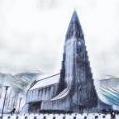Leaderboard
Popular Content
Showing content with the highest reputation on 07/14/2020 in all areas
-
First of all I will show the corrected version of the piece, right here: It is scored for 1 flute, 2 oboes, 2 clarinets, 2 bassons, 2 high horns in C, 2 trumpets in C, timpani (C,G,D,A), and strings. The compositiong plays around themes exposed in a sort exposition. The tonal travel is C-->G for the exposition then Cm-->Abm-->A-->F-->Bb-->(Gm-->Bbm-->C#m-->Em)x2 and finally the reexposition in C major. The movement is in sonata form, but is has some surprises. If you have any feedback please leave a comment. Version with mistakes:1 point
-
Good afternoon everyone! I'm fairly new to the forum, so I thought I would share something I wrote to introduce myself. I wrote this piece last year and finished around November, but just now decided to make a score so I could share it with you all. I'm interested in any and all feedback, as long as it's constructive. It is a rather long piece, so I included an outline if you would like to listen in "chunks". I used what you might call an "abbreviated sonata form": There is an Introduction, an Exposition stating two themes, an abbreviated Recapitulation of both themes, and a Resolution. (i.e. there is no development section) The outline is as follows: Introduction (0:00 - 5:13) Ominous opening, built around an ostinato figure (0:00 - 2:13) Lyrical theme (2:13 - 4:17) Return of ostinato figure, transition to exposition (4:17 - 5:13) A Theme of Exposition, somewhat manic and bombastic (5:13 - 7:09) B Theme of Exposition, pastoral yet deeply emotional (7:09 - 10:42) Brief transition to Recap of Exposition (10:42 - 11:21) Recap of A Theme, abbreviated (11:21 - 12:48) Recap of B Theme, abbreviated (12:48 - 15:07) Brief transition to Resolution (15:07 - 15:48) Resolution/Coda (15:48 - 19:21) As you listen, there are a few specific things I would be interested in your impression of: What is your favorite part? What is your least favorite part? While I have included a score and would certainly appreciate feedback on its appearance, I'm mostly concerned with feedback on technique, structure, orchestration, etc. How do you feel about the overall form? Does it work well? I am a former brass player, and know relatively little about string playing. Is my string writing convincing? What could be improved? What overall effect does the piece have on you? Does it create a certain image? Does it bring out a certain feeling? Anything else that jumps out at you. While I'm mostly happy with the way this piece turned out, there is certainly room for improvement. There are a lot of things I really like about it, but if I'm being real honest with myself I think the overall form falls a little flat, due to the lack of a development section. I dunno, maybe I'm too hard on myself, what do you guys think? Thanks for listening, and I hope you enjoy! If you have any questions about anything I did, feel free to ask and I will explain to the best of my ability. gmm New Piece for Orchestra.pdfNew Piece for Orchestra.mp31 point
-
Here my new Choral work for voice, strings and organ. It has no lyrics yet, but it definitely has to be for some religious purpose. I think it is a very solemn, optimistic and bright piece. Any comments are wellcome (I also appreciate suggestions for the lyrics 🙂).1 point
-
Wow, lots of great tips from everyone. I listened to this last night but wanted to wait a bit to review since it was so long, but it seems like a lot of what I would of said has been said. You say you've moved on from this one, so I won't beat a dead horse. Instead I'd just like to show my admiration for a work of this magnitude. I think you did a brilliant job here, and that was a great introduction (at least for me) to your music. I'll always look out for your name, I really dig your style. Keep me posted about your future works, I'm interested to see how such a great and unique voice evolves.1 point
-
This is a very good description of Delius. One might think him French for his elegance and lightness, but the no-nonsense of his music gives him away as staunchly British. Another composer who came to mind while listening to this was Koechlin, yet another quintessentially French composer. I'm no conductor either, but I'll put my suggestions together for the benefit (or detriment) of all.1 point
-
I'm glad to see you liked the piece. I usually dislike most of my compositions. And I will try to use more modern orchestral settings just in case I can get one of my compositions played by a real group of people. I might compose other works with the old orquestral setting but for now I think it's better for me to get used to the kind of instruments used nowadays and how to fully exploit their potential. Because if I get a job composing I will almost for sure use a modern orquestra.1 point
-
On a second listen with this in mind, this makes sense. I also think the big minor chord before it sets up the slow section very well, and the contrast in the dynamics makes it feel very dramatic. Nice work! Hey, if you like writing in this style I say go for it. I don't believe in the idea that just because Mozart and Beethoven may be the "masters" of this style that we shouldn't continue to practice it. If it's a valuable art for, it should be kept alive.1 point
-
Thank you a lot for your comment, I appreciate the feedback. I switch the melody to triplets as a way of repeating the second theme without using the same exact melody. Your idea of using other instruments as a rhythmical guidance (I didn't know how to say it haha) is really good, I never thought about it but I will take it into account. I composed a slow section because I wanted the piece to have some kind of tempo contrast and use it as a deep low point. Like, the developement travels to de deeps of the music and then returns in an epic way with the counterpoint part. I also was feeling quite depressed while doing it and I wanted to portray my apathy and I thought it could work. Glad you liked the counterpoint. And yes, I didn't know a lot about horns when I composed this, so what I created isn't very accessible for todays musicians. I wanted to use a horn that had more or less the same range as the trumpet in C, but it seems that isn't a thing. Anyway for next time I will compose thinking in terms of modern instruments instead of natural trumpets and all that old stuff.1 point
-
My advice would be to start out small. When I first started investing money into this hobby I used Garritan Personal Orchestra (I think about $100) and the basic version of Cubase ($50 or $100 I can't remember). While relatively simple, it's a good way to get used to interfacing with a DAW and orchestral libraries. Then when you're more comfortable, you can step up to a larger quality library. If I find some of these old compositions I might post them just for grins. Thanks for the suggestions, I will check these out!1 point
-
Thanks! I haven't done much experimenting with sound libraries yet. The sound quality is a big step up from standard MIDI, so I'd like to start using sound libraries at some point, but I've heard they can be quite time-consuming, and I'm not sure I have the technical expertise or patience to get the most out of them. You've probably heard Delius's music, even if you've never heard of him. The Florida Suite and On Hearing the First Cuckoo in Spring are both excellent introductions to his work. He's sort of a more Romantic and English (and therefore straight-laced) cousin to Debussy, yet wholly original at the same time. I hadn't noticed, to be honest. Now that you point it out, I can see that the similarities in the opening measure of the two pieces, but they go in very different directions after that, so I don't think it's an issue. If you want to see some true Mahler ripping-offing, then check out "Hell's Picture Scroll" from the Ran soundtrack. If you know your Mahler, then you'll recognize the similarities right away (hint: Das Lied von der Erde). Ah. No issues there then.1 point
-
@Vogel thank you for your kind words, and welcome to the board! I used Spitfire Symphonic Orchestra for all of the Strings, Brass, and Woodwinds, and Spitfire Percussion for the percussion. The only outlier is the harp, for which I just use Garritan Personal Orchestra with Fabfilter's Pro-R to give the sound that it's in a hall. Thank you, this comparison is very kind of you. I love Stravinsky (particularly the Firebird) and Debussy. I've never even heard of Delius however, so I will be sure to check him out. Do you have any of his works you would recommend? I'm glad you liked it. I have no problem being compared to Strauss! I'm glad you pointed out this chord because it might be my single favorite chord in the whole piece. If you want more detail behind how I came up with it I would be happy to discuss via Message. I see what you are saying, but I like it as it is. I want this moment to feel more "piercing" rather than an immense rush. The piece I drew inspiration from on this passage, and the section preceding it, is Mahler's 7th Symphony, starting at about 13:03 in the below link. You might also notice I tried to borrow from the beginning of this piece with the opening of my piece. (Hopefully it's not too much borrowing lol). In the score, I noted for the player to change every two bars to allow for breaks. When the whole section comes in later, I'm fine with them staggering their breathing to make sure all notes are played. I've been grappling with the idea of a larger multi-movement piece such as a symphony. I imagine I could come up with a suitable symphonic form, but I'm trying to get my head around what I want my symphony to be from philosophical standpoint before I make such an attempt. Though if/when the time comes, I think I would rather start with something new and fresh. At least for now, I think I will let this piece be. Thanks for listening and critiquing!1 point
-
Very well written. You clearly have a good grasp of string writing and very good melodic tone. just a few things Bar 34. that chromatic quadruplet doesn't work, it's way too jarring in my opinion due to all the parallel voicing. I'd either re-voice it or scrap it. Bar 86. I think you could do a lot more with this idea, it's a gorgeous melody. I think you've hit a goldmine with that one. it don't feel it's exploited nearly enough. Bar 133 That in my opinion is way too weak a resolution to return to the primary theme, you need the full dominant seventh chord to fill it out and really pull the Listener back to D minor. A general observation I would be more careful with your time signature changes. they felt far to abrupt in many places to truly fit, I think you'd be better off just allowing the theme to cross bars creating a less strict rhythmical feel. I did enjoy the piece and I look forward to hearing more from you 🙂1 point
-
Most composers today who say they can't read music actual can, just not very well or it's just not the main way they do things. But to say Hans Zimmer and Danny Elfman can't read music is not entirely accurate, nor does it logically make sense considering their need to collaborate with notation-literate musicians and editors and publishers and copyright lawyers on daily basis. if you walked up to them and thrust a musical score in their hands, they won't find it an unintelligible mass of blobs. They're more than capable of identifying notes on sheet music. That's just not their main method of composing, usually. You might appreciate this video I found of Paul McCartney actually diving into his compositional process using a computer for his classical music. He too, can read music, he understands exactly what different pitches and chords are and what they sound like, but that's just their most natural and expedient method of creation. I can read piano rolls, I can read DAW timelines--but I'm slow at it and find it inefficient, for me. A composer should know as many information mediums as possible.1 point
-
This is nice. Much of your material centers on the Monte Principale schema, or the rising by 4ths-falling by 5ths bass motion. It is also known as the sequential version of the falling circle of 5ths. In respect to the first appearance of this idea, your first violin is doubling second trumpet part. I personally would avoid this, and make use of suspensions. I would also look to expand the thematic material beyond this schema as it appears 3 times in succession in the B section with a little variation. Overall, it works with the ideas used making coherent sense. To illustrate the suspensions, see below:1 point
-
What works am I copying? I got inspiration from Mozart's Jupiter and Beethovens Eroica, but I don't think I'm copying that much. Anyway it doesn't matter because now that I have heard what I created I'm simply ashamed of it. My biggest failure by far. I will just try to forget I ever composed that piece of rubbish, I knew I did some mistakes but the reality was too bad honestly and I got really annoyed with myself.1 point




